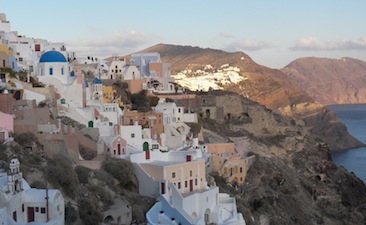
Santorini was named by the Latin Empire in the thirteenth century, and is a reference to Saint Irene, from the name of the old cathedral in the village of Perissa. Before then, it was known as Kallístē (the most beautiful one), Strongýlē (“the circular one”), or Thēra. The name Thera was revived in the nineteenth century as the official name of the island and its main city, but the colloquial name Santorini is still in popular use.
Akrotiri, on Thira, is a wellspring of information on the nature and environment of the Bronze Age, the people residing there, their occupations and their diet. Information concerning the agricultural economy sector also includes data on vini-culture and wine-making.

By far though, Santorini reaps worthily the fruits of the most important wine-producing island of the Cyclades, if not of the whole of Greece. It is one of the most difficult lands that vines can be planted the rain is scarce, air and ground humidity are almost non-existent, the wind is persistent and severe, the heat is extreme, the sunlight is ample, the soil is infertile… It is strange (or is it expected?) that the wines produced from this land are, at least, magnificent : full of density and power, with aromas and flavours that are always complex but never over the top, and a splendid balance between a crisp acidity and richness from alcohol. It is also the most interesting island in this domain. There are about 10 local grape varieties, many of which have been known since antiquity. Nowadays, only a few of them are commercially exploited for wine production. The most important variety is the Asyrtico, which dominates the island followed by the white and light Aidani which resembles the Muscat. All these different types of wine share a common stylistic thread. They are based on their palate structure rather than their aromatic flamboyance, an attribute that makes them perfect food wines not just with the exquisite indigenous small tomatoes, Santorinini’s famous fava beans, capper leaves and many other local dishes, but with any cuisine that can match so concentrated wines.
These and an even larger variety of Santorini’s wines can be found in the Wine Museum-Winery Kotsoyannopoulos. The Wine History of the Kotsoyannopoulos family started in 1870 by brothers, Gregory and Dimitri Koutsoyiannopoulos. Exports to Odessa in Russia were the bulk of sales from 1870 to 1917. Russian Revolution in 1917, closed the capital of exports. However, open new markets in Western Europe, France and Italy. The preference of Santorini wine confirms the high quality wine. before coming first winery bottling the wine was sold in bulk in Santorini with Secchi (1 Secchi = 10 liters), the few customers on the island. Just because every family makes its own wine. Today, the winery continues, the fourth generation to with care and supervision of the owner mr George Koutsoyannopoulos having won many wine awards both in Assyrtico and Vinsanto such as:
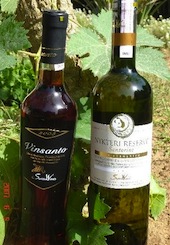
• 2008 International Competition London Decanter (World Wine Awards), Silver Medal 2009
• Contest 2009 International London Decanter (World Wine Awards), Bronze Medal – 2010
• 2010 Wine Spectator, prestigious magazine, 91 points with honors 100, the highest score obtained Santorinian wine – 2010
Vinsanto Vintage 1959: Wine-plus.de, German Web Magazine, 95 points with honors 100, the highest score obtained Greek wine – 2010
Maintaining and improving the quality of wine and feel the presence of the bottle and label a picture of a complete set of highest quality ever. The establishment of the Wine Museum in the same property that houses the winery, is a cultural legacy of the “Today”.
The unique in Greece, underground Wine Museum, 8 meters below the ground and 300 meters long, shaped labyrinth, showing the history of the wine and the life of wine producer in Santorini from 1660 to 1970. With representations from mobile and stationary models, automatic electronic personal tour in fourteen languages. In the museum, all issues are presented in order. The stages of the production of wine and all the machines out in chronological order. The pruning, plowing the land, the harvest the pressing and the weight of the grapes. The rare exhibits, wine-making machinery and tools will transport the visitor to another year We finished the tour with the office of the founder of the winery Mr Gregory Koutsogiannopoulos all personal items and office supplies from the year 1870. Finally, the visitor keeps the memory of all the knowledge from the trip in the past. In the end, the visitor has the opportunity to try four from our best wines. The Cycladic culture, and how the difficulties of life stages of wine production, attract thousands of visitors each year. For more information visit our website online:
http://www.wine-museum.gr
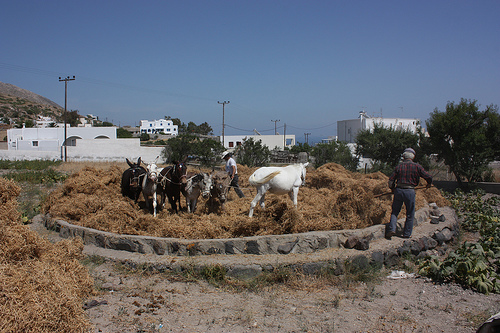
All these different types of wine share a common stylistic thread. They are based on their palate structure rather than their aromatic flamboyance, an attribute that makes them perfect food wines not just with the exquisite indigenous small tomatoes, Santorini’s famous fava beans, capper leaves and many other local dishes, but with any cuisine that can match so concentrated wines.
What makes the Santorini fava the best among the varieties cultivated in other parts of Greece and the Mediterranean region in general, is the volcanic terrain of the island, it’s the most arid in Greece, are extremely harsh.
The very little amount of humidity in the ground means that the few vegetables growing have a very intense taste. The Santorini fava is characterized by its dark yellow color and its taste reminding dried fruits. It takes more time to cook and housewives of the island let it simmer for many hours in order to achieve a dish of creamy texture. This simple food is a basic raw diet material for the island and the corner stone of the local cuisine. It is found in dozens of different dishes like the common mashed split peas, in balls and soups. The leftover fava can be mixed with other ingredients like cooked onions or cooked dry capers and in these case the local people call it “fava padremeni’’ (wedded). One of the tastiest dishes is fava accompanied by cooked eggplant on top.
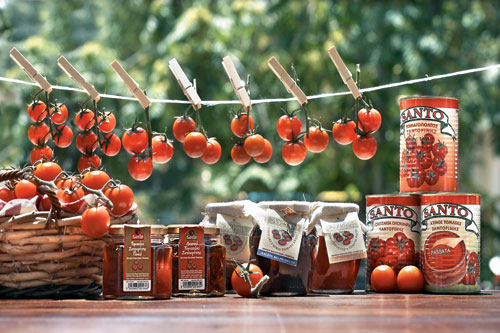
The folklore scientist from Santorini I. Kyriakos in 1875 mentions the Santorini tomato as ‘chrysomilo’ (golden apple). The cultivated variety is anhydrous with small fruit and bushy. The size of the tomato sometimes can reach the size of a cherry! Its bark is hard and has a unique flavor. As it is obvious the flavor of the tomato paste produced by the Santorini tomato is unique also.The tomato production was a big enterprise in Santorini before tourism changed the landscape. In a region with such a dry climate, only one unique variety could grow. Until the ‘50s, the cultivation and canning of the tomatoes played the most basic role in the Santorini economy. One of the dishes bearing the signature of the island is the “pseftokefteves’’ (fake meat-balls). These are fried balls prepared with tomatoes, herbs and batter.
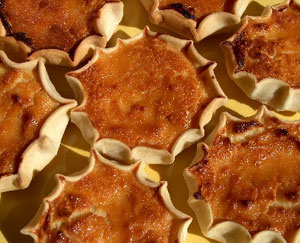
KOYFETO: This is a specialty of Santorini and nearby islands. It is prepared with blanched almonds boiled in syrup from local honey. This is the traditional sweet for weddings. Indeed, even before tasting it, its appearance makes us feel we are about to experience a delight of the palate.
MELITINIA :These are Easter sweet cheese-pies which fresh, unsalted myzithra (ricotta). This cheese is prepared only during the Easter season. In the filling various herbs are used. Some cooks add mastic, others cinnamon, orange and vanilla, or a mixture of those. Since these are festive sweets, their shape is special, resembling small tarts; the may even look like a star, in the center of which the filling is added. It becomes apparent that Santorini, though small in size, has already made a big name in gastronomy and is considered to be a gastronomical destination with some of the finest restaurants.
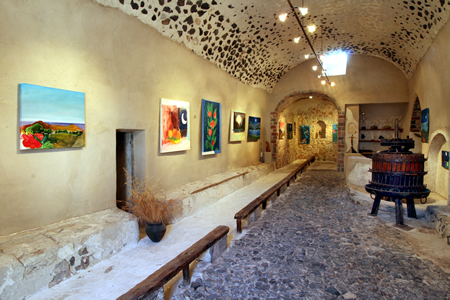
But there’s more to Santorini than the divine wine and food. For those who fancy museums the cultural center Art Space is the place to be. From the winery to the contemporary painting and Sculpture offers a travel from old wineries to exceptional modern art. Art Space at Santorini’s Exo Gonia continues from 1999 till today its art activities and extends its hospitality to important artwork by Greek and foreign artists.
A unique art center within the pumice rock – carved chambers of an old winery. In this old winery dating back to 1861, representative works of art from the sphere of painting and sculpture are on display, offering visitors the opportunity to come close to contemporary Greek art and the course of artistic expression in Greece. What is more, Art Space, in its endeavor to continue the wine-making tradition includes in its premises a modern winery offering renowned products of high quality. Open Daily: from 11a.m. to sunset
Where to stay: Aqua Vista Hotels
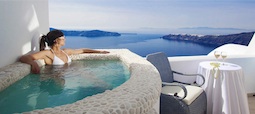
How to get there: Palaiologos Shipping & Travel Enterprises
See all the latest news from Greece and the world at Greekreporter.com. Contact our newsroom to report an update or send your story, photos and videos. Follow GR on Google News and subscribe here to our daily email!




